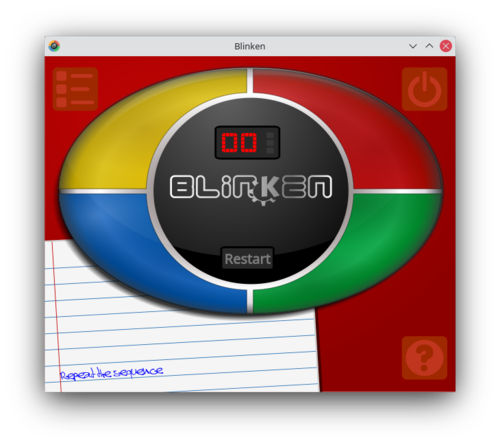BlinKen: Difference between revisions
Markup edit |
Converted dko link to new standard |
||
| (4 intermediate revisions by 3 users not shown) | |||
| Line 1: | Line 1: | ||
<languages /> | <languages /> | ||
<translate> | <translate> | ||
<!--T:1--> | |||
{{EduBreadCrumbs}} | {{EduBreadCrumbs}} | ||
<!--T:2--> | |||
{|cellpadding="10" | {|cellpadding="10" | ||
| [[Image:Blinken.png|64px]] | | [[Image:Blinken.png|64px]] | ||
| ''' | | '''Blinken''' is our version of the well-known game Simon Says. <!-- |} --> | ||
It is part of the [http://edu.kde.org KDE Education Project]. | <!--T:3--> | ||
It is part of the [http://edu.kde.org KDE Education Project]. <!-- {| --> | |||
|} | |} | ||
<!--T:4--> | |||
[[Image:BlinKen_welcome.png|500px|center|thumb]] | [[Image:BlinKen_welcome.png|500px|center|thumb]] | ||
==Description== <!--T:6--> | |||
==Description== | |||
<!--T:7--> | |||
'''Blinken''' is based on an electronic game released in 1978, which challenges players to remember sequences of increasing length. | '''Blinken''' is based on an electronic game released in 1978, which challenges players to remember sequences of increasing length. | ||
<!--T:8--> | |||
On the face of the device, there are 4 different color buttons, each one with their own distinctive sound. These buttons light up randomly, creating the sequence that the player must then recall. If the player is successful in remembering the sequence of lights in the correct order, they advance to the next stage, where an identical sequence with one extra step is presented. If they are incorrect, the game is lost, and the player must start again from the beginning. | On the face of the device, there are 4 different color buttons, each one with their own distinctive sound. These buttons light up randomly, creating the sequence that the player must then recall. If the player is successful in remembering the sequence of lights in the correct order, they advance to the next stage, where an identical sequence with one extra step is presented. If they are incorrect, the game is lost, and the player must start again from the beginning. | ||
<!--T:9--> | |||
The goal is to get a high score - each step in the sequence is worth one point, so correct entry of a sequence of 8 lights is worth 8 points on the high score table. | The goal is to get a high score - each step in the sequence is worth one point, so correct entry of a sequence of 8 lights is worth 8 points on the high score table. | ||
==Documentation== | ==Documentation== <!--T:10--> | ||
* [http://docs.kde.org/ | <!--T:11--> | ||
* [http://docs.kde.org/?language=en/kdeedu/&application=blinken Blinken Handbook ] | |||
<!--T:12--> | |||
[[Category:Education]] | [[Category:Education]] | ||
</translate> | </translate> | ||
Latest revision as of 06:10, 6 November 2014
Home » Applications » Education » BlinKen

|
Blinken is our version of the well-known game Simon Says.
It is part of the KDE Education Project. |

Description
Blinken is based on an electronic game released in 1978, which challenges players to remember sequences of increasing length.
On the face of the device, there are 4 different color buttons, each one with their own distinctive sound. These buttons light up randomly, creating the sequence that the player must then recall. If the player is successful in remembering the sequence of lights in the correct order, they advance to the next stage, where an identical sequence with one extra step is presented. If they are incorrect, the game is lost, and the player must start again from the beginning.
The goal is to get a high score - each step in the sequence is worth one point, so correct entry of a sequence of 8 lights is worth 8 points on the high score table.
